Peru << puh ROO >> is the third largest country in South America. The country covers an area of 496,225 square miles (1,285,216 square kilometers). Only Brazil and Argentina cover a greater area. Peru is a land of enormous contrasts in landscape and climate. The country lies in western South America along the Pacific Ocean. The long, narrow coast consists of a desert even drier than the Sahara. Most of Peru’s large cities lie in this region, including Lima << LEE mah >>, the capital and largest city. The towering, snow-capped Andes Mountains rise east of the coast and extend north and south down the entire length of the country. This region, called the Sierra, is famous for its grassy plateaus, clear air, and sunshine. The Altiplano, one of the highest, largest plateaus in the world, covers southeastern Peru. East of the Andes is the Selva, a hot, humid region covered by the Amazon rain forest.

A large majority of Peruvians identify as Indigenous (native) or mestizo. Mestizos are people with both Indigenous and European ancestry. Only a small percentage of the population is made up of white people.
Peru is one of the world’s leading producers of copper, gold, lead, silver, and zinc. It also ranks among the world’s leading fishing countries.
For most of the 1400’s and 1500’s, Peru was ruled by the Inca, who built a great empire along the western coast of South America. White people first reached Peru in the 1520’s, led by the Spanish conquistador (conqueror) Francisco Pizarro. They conquered the Inca in the 1530’s and made Peru a Spanish colony. Peru declared its independence from Spain in 1821.
Government
Peru has had a number of constitutions since it became independent in 1821. The latest constitution was adopted in 1993. Although each constitution has declared the country to be a democratic republic, dictators have ruled Peru many times.

National government.
Under the Constitution of 1993, a president serves as head of state and head of the government. The president is elected by the people to a five-year term. After completing his or her term, the president must wait five years to run for reelection. The voters also elect two vice presidents. The president appoints a Council of Ministers, including a prime minister, to help direct the government. A one-house Congress is responsible for making the country’s laws. The people elect the 130 members of the Congress to five-year terms. The Supreme Court is Peru’s highest court.

Peru's national anthem
Local government.
Peru is divided into 24 departments with regional governments. Each department is subdivided into provinces, and each province, into districts. Two provinces—Callao and Lima—are exceptions to this administrative structure. The Constitutional Province of Callao is not part of any department and has its own regional government. The province of Lima, which covers roughly the same area as the city of Lima, is governed by the Metropolitan Municipality of Lima, an independent regional-level government.
The armed forces.
Peru has an army, navy, air force, and army reserve. The armed forces, especially the army, have traditionally played an important role in Peruvian life. Besides being deeply involved in politics, the armed forces assist in such activities as police work and roadbuilding. Military service is voluntary.
People
Population.
Most of the country’s people live in cities or towns. Lima, which has a population of about 9 million, is by far the largest Peruvian city. Lima and the neighboring city of Callao make up Greater Lima. Other large cities in Peru include Arequipa on the southern coast and Trujillo in the north. For more information, see the separate articles on Peruvian cities listed in the Related articles at the end of this article.

Ethnic groups.
After the Spanish conquest of Peru in the 1500’s, some Spaniards and Indigenous people intermarried. Their descendants became known as mestizos. Since about 1900, migration, modernization, and urbanization have led to growth of the mestizo population. Today, about 60 percent of Peruvians identify themselves as mestizo, and about 25 percent, as Indigenous. Among Peruvians, ethnic identity is defined both physically and culturally. This is especially true of mestizo identity. Sometimes the difference between mestizo and Indigenous identity depends on one’s occupation, ability to speak Spanish, and residency in a city. About 6 percent of Peru’s people are white. The rest of the people belong to other ethnic groups, including people of African, Chinese, and Japanese descent.
Languages.
Spanish became Peru’s official language soon after the Spanish conquest. In 1975, the Peruvian government made Quechua, the language of the Inca, an official language along with Spanish. Since then, the government has made Aymara and other Indigenous languages official in areas where they are predominant.
Spanish is the principal language of more than 80 percent of the population. The rest primarily speak an Indigenous language. Many Peruvians speak both Spanish and an Indigenous language. Quechua is by far the most common Indigenous tongue. It is the principal language of about 15 percent of Peruvians, especially those who live mainly in the Sierra, or highlands, region. A much smaller number speak Aymara, the language of a people conquered by the Inca in the 1400’s. In the rain forests of eastern Peru—a region called the Selva—Indigenous groups speak a variety of other languages.
Ways of life.
Peru’s Spanish conquerors established a strict class system based on ancestry. A small upper class made up of white people controlled a huge lower class made up of Indigenous peoples, mestizos, and people of African descent. This class system lasted until about 1900, when a small middle class of white people and mestizos began to develop. Peru’s middle class grew steadily during the 1900’s. However, Peru remains a highly unequal society, and its small upper class still consists mostly of white people.
White people.
About half of the white people in Peru belong to the upper class and about half to the middle class. A small number of white Peruvians belong to the lower class. The white people speak Spanish. Upper-class white families, who have traditionally controlled much of Peru’s wealth, seldom mix with people outside their class. Most of their children marry into other upper-class families. Most of these families live in fashionable sections of Lima and other large cities.
Mestizos,
like white people, speak Spanish. They have generally had closer ties with the white community than Indigenous people have had. For example, white owners of mines and plantations traditionally hired mestizos to supervise Indigenous workers. The growth of Peru’s cities and of the middle class has given mestizos other opportunities for advancement. Today, many middle-class mestizos attend college and become leaders in government, industry, the armed forces, and white-collar professions (office-based work). A small number of mestizos have acquired enough wealth and social standing to be accepted into the upper class.
Indigenous people.
Peru’s Indigenous population is extremely diverse, with many different local customs, languages, and traditions. In general, Indigenous people are much more likely to live and work in rural, rather than urban, areas. As a result, they often have limited access to education, health care, and public utilities.
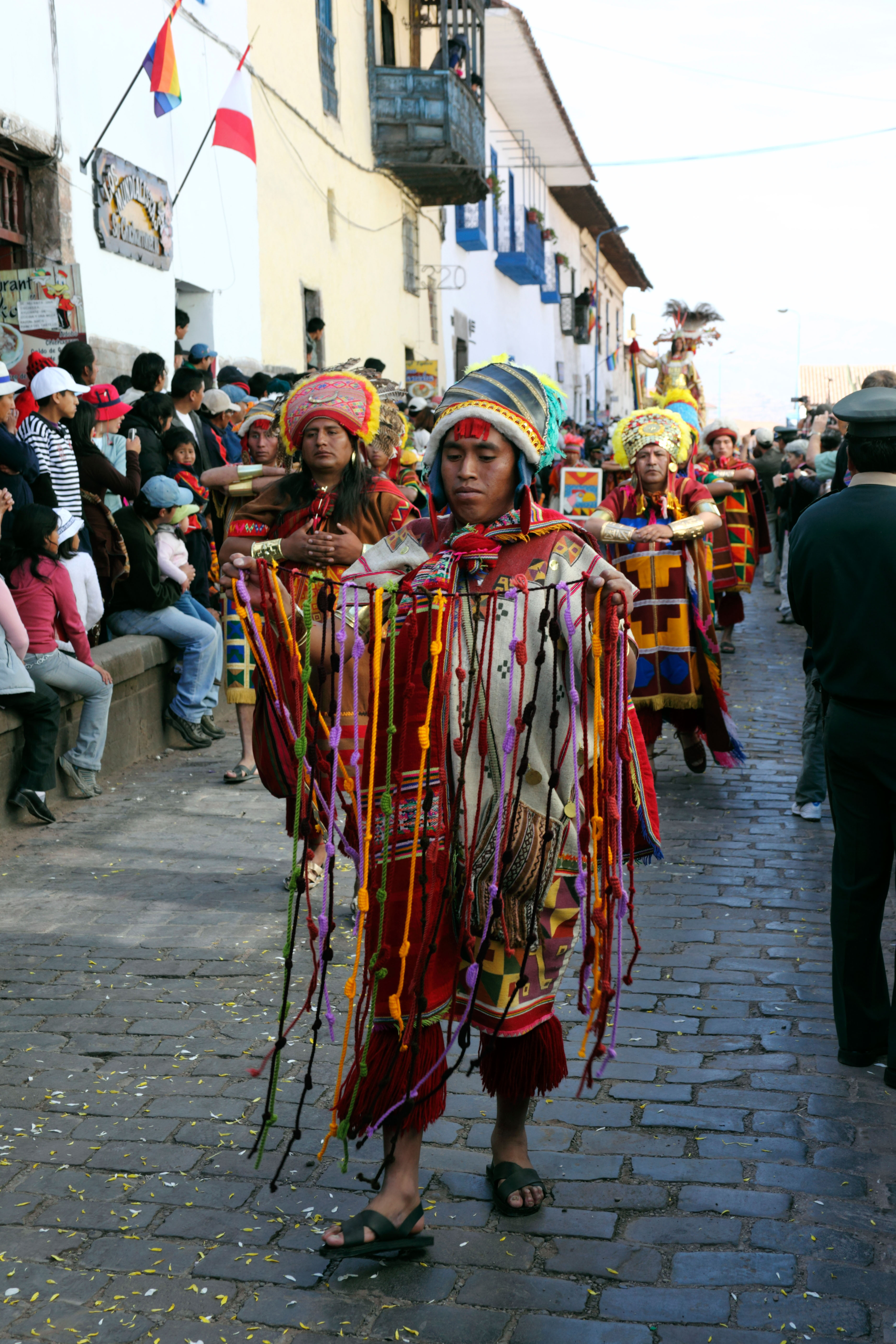
Indigenous people in the highlands live at elevations up to 15,000 feet (4,570 meters). The Himalaya mountain system in southern Asia is the only other place in the world where people live at such high altitudes. Many Indigenous highlanders live by farming, but they also trade goods and services to get what they need. In addition, they often migrate to coastal agricultural areas to do seasonal work. Indigenous highlanders may wear modern clothing or traditional handwoven textiles, or a combination of both. They often speak Quechua mixed with some Spanish and English.
The Indigenous people of the Selva speak many different languages. Some groups in the Selva live in isolation and grow and hunt for most of their food. Others, especially those living near urban areas and highways, have adopted modern customs.
Since the mid-1900’s, many Indigenous people have moved away from the highlands and the Selva to work on coastal plantations. Many others have moved to cities in the coastal region. This migration has contributed to the growth of Peru’s mestizo population.
Housing.
Most rural families in Peru build their own houses. The typical house has one room. In the highlands, most houses have walls of adobe and a roof of grass thatch or handmade tile. Most homes in the Selva have walls built of wood and a roof of palm thatch. 
Many kinds of housing can be found in Peru’s cities. In upper- and middle-class neighborhoods, the people live in comfortable single-family homes with enclosed patios. The largest cities also have high-rise apartments and modern public housing. However, much urban housing in Peru is extremely poor.
Some lower-class families in Lima and other large cities live in crowded slums with poor sanitation. Others live in squatter communities on public land on the edge of the cities. Most squatters first build a home of cardboard, old metal, and other scrap. Many squatters eventually save enough money to build a permanent house of adobe or concrete block. To encourage these efforts, the government has named the squatter communities pueblos jóvenes (young towns) and supplied many with running water and a sewerage system.
Food.
Most upper- and middle-class families in Peru eat a varied diet of meat, fish, poultry, vegetables, and grain products. They season many main dishes with onions and hot peppers. Rice, potatoes, or bread accompany most main meals.
The majority of lower-class families in Peru eat less meat than wealthier Peruvians do. The diet of Indigenous people living in the highlands consists largely of beans, corn, potatoes, soups made of barley or wheat, and squash. Many Indigenous people of the highlands chew the leaves of the coca plant to relieve feelings of cold, exhaustion, and hunger. A natural substance in coca leaves stimulates the nervous system, like coffee does. This substance is also used to make the illegal drug cocaine (see Coca; Cocaine). The Indigenous people of the Selva have a somewhat more varied diet. They raise basic crops, such as bananas, corn, and cassava, a starchy root. However, the rain forest provides them with many varieties of fish and small game and many types of fruits and nuts.
Recreation.
Music and dancing are extremely popular throughout Peru. Radio stations play everything from traditional Peruvian music to the latest hit songs from the United States. Indigenous musicians play traditional music on drums, flutes, rattles, and a kind of small harp. Mestizo music also uses these instruments, as well as guitars, fiddles, horns, and other instruments. Mestizo bands attract large crowds in cafes and dance halls throughout Peru. Motion pictures are also a popular form of recreation in Peru. Loading the player...
Peruvian folk music
Soccer, which Latin Americans call fútbol, ranks as the most popular sport in Peru. The country’s national soccer teams play against teams from other countries in Lima’s 70,000-seat National Stadium. Many Peruvians also enjoy basketball and volleyball.
Almost every city and town in Peru holds an annual festival, called a feria, to honor its patron saint. Ferias include colorful religious processions, feasting, dancing, and games. Peru celebrates the anniversary of its independence on July 28.
Education.
Almost all Peruvians 15 years of age or older can read and write. The great majority of those who cannot read or write live in rural areas, and most are Indigenous people. Most educated Peruvians live in the cities, which have by far the greatest number of schools.
Peruvian law requires all children from the ages of 6 to 16 to attend school. However, some rural children cannot meet this requirement because of a shortage of schools and teachers. Most elementary and high school students attend free public schools. Nearly all students from middle- and upper-class families go to private schools, which charge a tuition fee. Peru has many universities, including the famous National University of San Marcos in Lima. Founded in 1551, it ranks as the oldest institution of higher learning in South America.
Religion.
Roman Catholicism is the official state religion of Peru, but the government grants freedom of worship to all religious groups. Catholicism is taught in public schools throughout the country. About 75 percent of the people of Peru are Roman Catholics, but relatively few attend church regularly. Many Indigenous people combine Catholic and traditional Indigenous religious beliefs. There are also many evangelical Protestant groups in Peru. Such groups emphasize personal religious experience and the authority of the Bible. 
The arts.
Peru’s artistic traditions date back nearly 3,000 years, when Indigenous Peruvians began to create beautiful jewelry, pottery, sculpture, and textiles. Peru’s Indigenous people still practice these arts and crafts. The Inca were expert architects. Examples of their architectural skill, such as the temples and terraced slopes of Machu Picchu, still stand in parts of the Sierra.

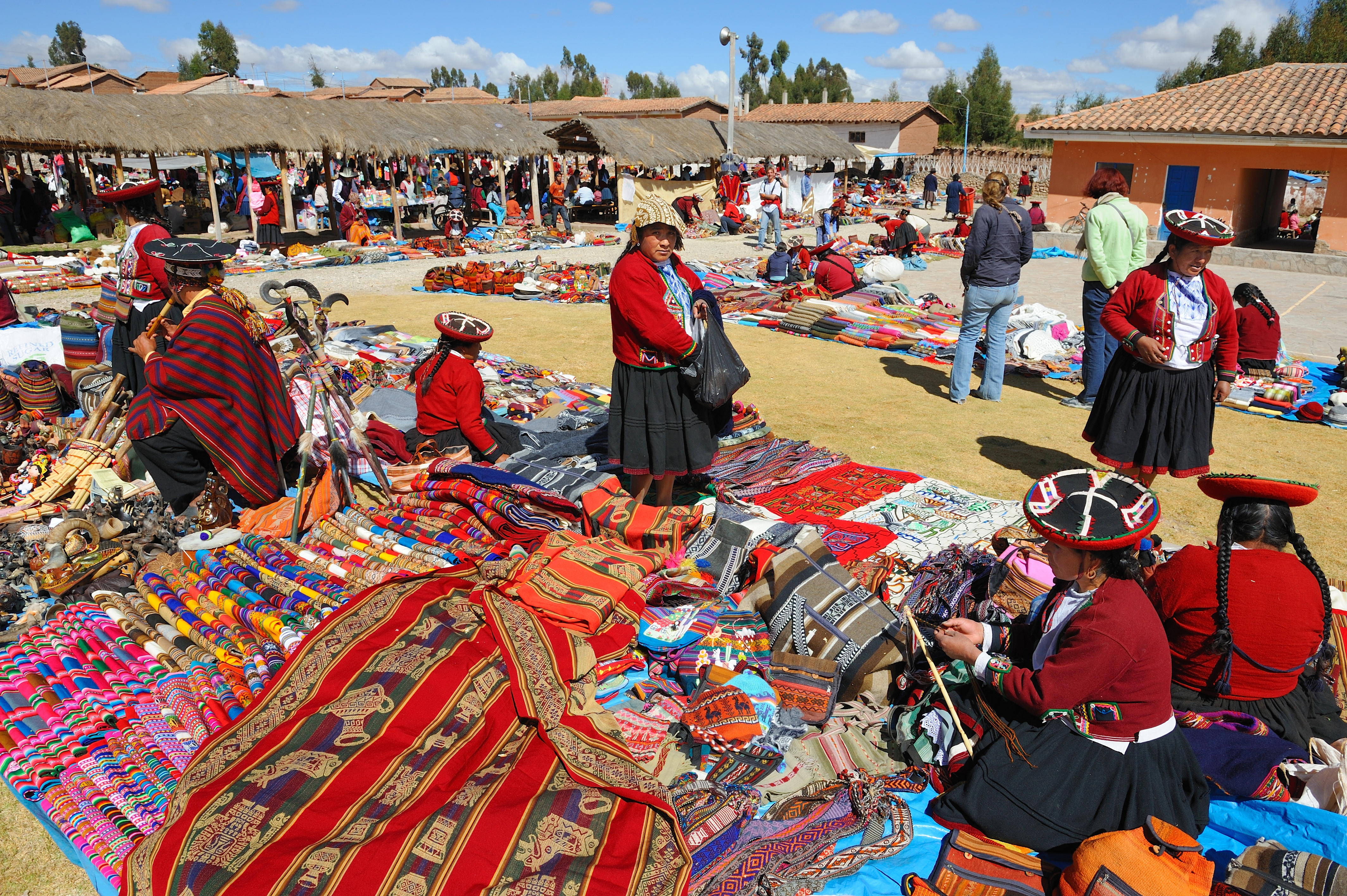
Spanish colonists constructed many richly decorated churches and public buildings in Peru. Earthquakes have destroyed many of these structures, but some have been rebuilt. Examples of colonial architecture can still be found in the historic centers of most cities and towns.
One of the earliest Peruvian writers to rise to international fame was Inca Garcilaso de la Vega. His histories of the Inca and the Spanish conquest were widely read in the Americas and Europe in the late 1500’s and early 1600’s. In the late 1800’s and early 1900’s, Ricardo Palma won fame throughout the world for his stories about life in colonial Peru. Later in the 1900’s, a number of talented Peruvian authors championed the cause of the Indigenous population. They include the political writer José Carlos Mariátegui, the poet César Vallejo, and the novelists Ciro Alegria and José María Arguedas. During the 1960’s and 1970’s, Mario Vargas Llosa became famous for his novels about the relations between Peru’s social classes. Notable novelists of the late 1900’s and early 2000’s include Jaime Bayly and Santiago Roncagliolo.
Land regions
Peru has three main land regions. They are, from west to east: (1) the Costa, or coast, along the Pacific Ocean; (2) the Sierra, or highlands, the highest parts of the Peruvian Andes; and (3) the Selva, a region of rain forests and rivers. Earthquakes occur frequently in Peru. Most of them center in the highlands, and their effects extend to the coast and rain forests.
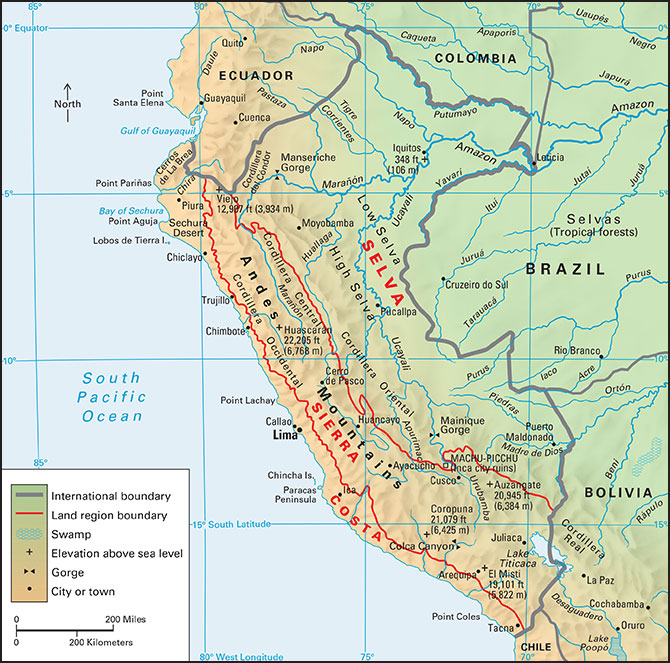
The Costa
consists of a long, narrow strip of coastal land between the Pacific Ocean and the highlands. The region includes the western foothills of the Peruvian Andes. Most of Peru’s large cities, commercial farms, and factories lie along the coast. Nearly all the coast is dry, rugged desert, but about 50 rivers, which flow from the mountains, cross the region. The rivers provide irrigation water for coastal farms as well as drinking water for the towns and cities.
The Sierra,
or highlands, consist of all areas of the Andes Mountains above 6,500 feet (1,980 meters). Narrow valleys and plateaus make up much of the region. The tallest peaks have snow the year around, and some have permanent glaciers. The highest peak is 22,205-foot (6,768-meter) Huascarán, an extinct volcano. Few trees grow in the highlands, but many of the valleys have a thick cover of grass. The Indigenous people use these valleys for grazing herds of livestock, especially llamas and sheep. 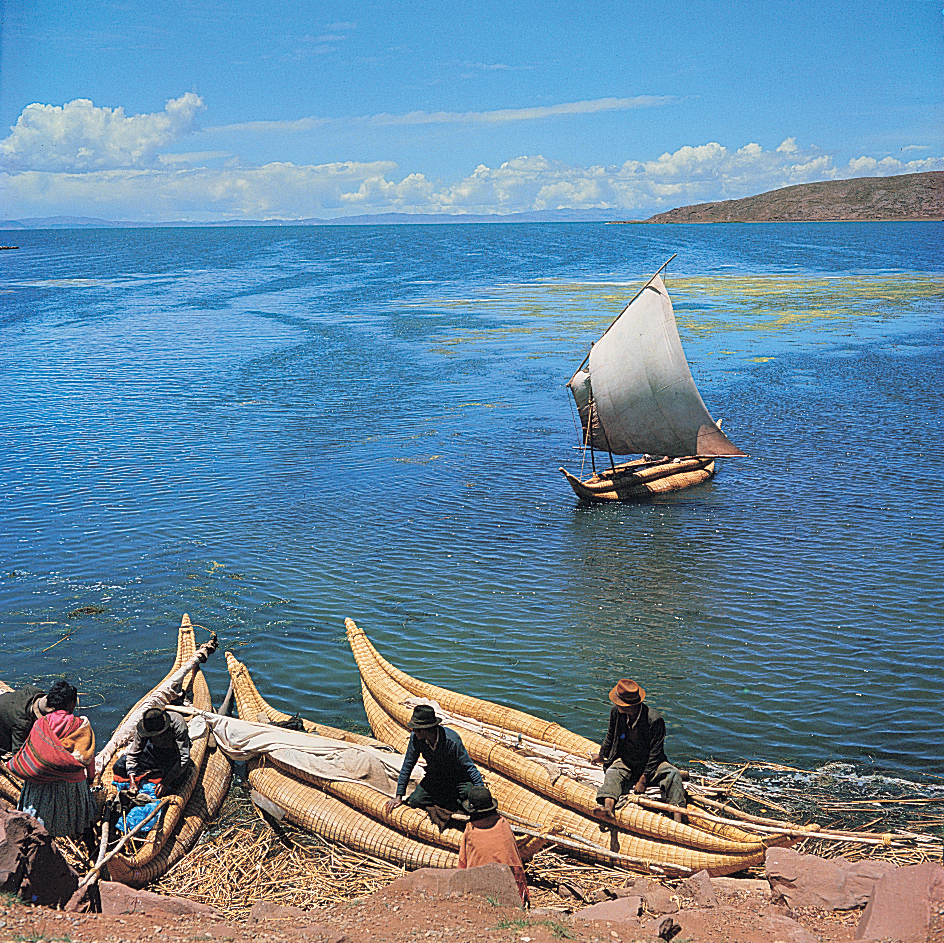
Lake Titicaca, in the southern Sierra, is South America’s largest lake. Part of the lake lies in Bolivia. The Peruvian part covers 1,914 square miles (4,957 square kilometers). Lake Titicaca lies 12,507 feet (3,812 meters) above sea level. It is the highest navigable lake in the world.
The Selva
is part of the Amazon River Basin. The Amazon is the world’s largest river by water volume. The Selva has two subregions—the high Selva and the low Selva. The high Selva consists of the eastern foothills of the Andes. Unlike the dry western foothills, the eastern foothills are covered with green forests. The low Selva descends eastward from the high Selva. It consists mostly of low hills and flat plains covered by thick rain forests. 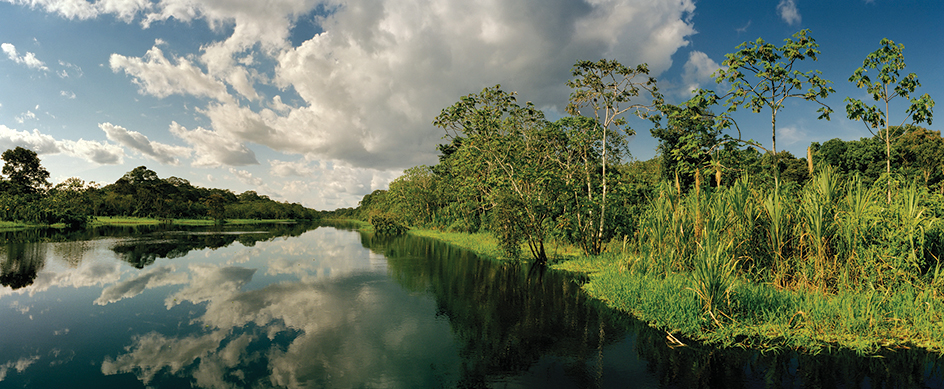
Climate
Peru lies entirely within the tropics. But the Peru Current, an unusually cold ocean current, makes the coast cooler than is normal for a tropical region. Coastal temperatures average 73 °F (23 °C) from November through April and 61 °F (16 °C) from May through October. Because of the high altitudes, temperatures in the highlands range even lower than do coastal temperatures. At the highest elevations, the temperature never rises above freezing. At elevations below 10,000 feet (3,000 meters), frosts never occur. Most of the Selva has high temperatures all year. In many places, the temperature averages nearly 80 °F (27 °C).
The amount of rain, snow, and other forms of precipitation increases greatly from the coast to the Selva. Because the air along the coast is cool, it cannot hold much moisture. In addition, air from the east loses its moisture in the Andes before it reaches the coast. As a result, the coast seldom receives more than 2 inches (5 centimeters) of rainfall a year.
Much of the western highlands region gets less than 10 inches (25 centimeters) of annual precipitation. The eastern highlands and the Selva have a wet season from November through April and a dry season from May through October. Most of the Selva has at least 80 inches (200 centimeters) of precipitation annually, and some parts of the high Selva get more than twice that amount.
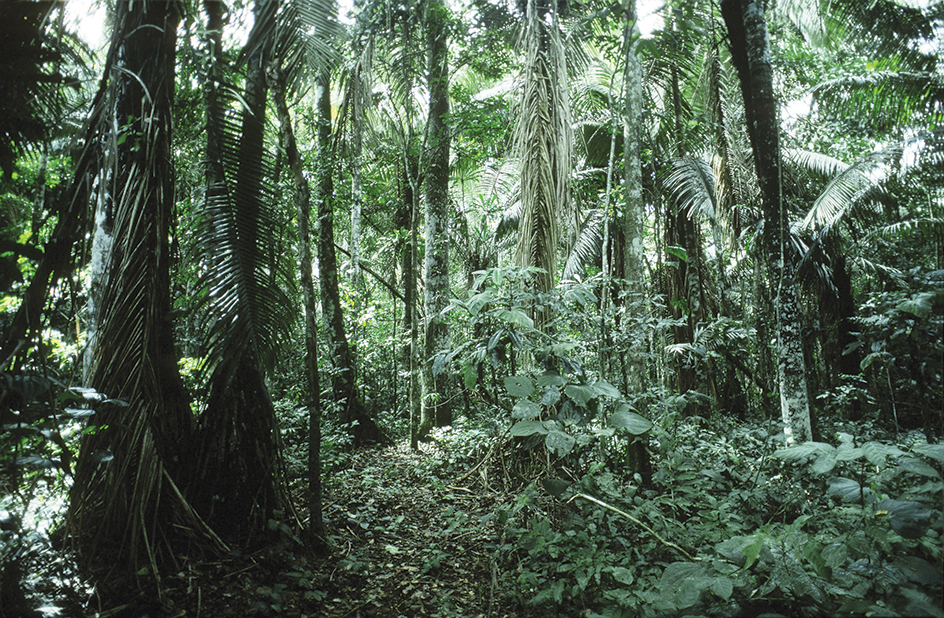
Economy
Agriculture, fishing, and mining are important to Peru’s economy. Much of Peru’s manufacturing is based on the processing of the country’s natural resources. Agricultural, fished, and mined products also make up a large portion of Peru’s exports. Peru has a relatively high poverty rate. Service industries account for more than half of Peru’s economic production and employ more than half of its workers.
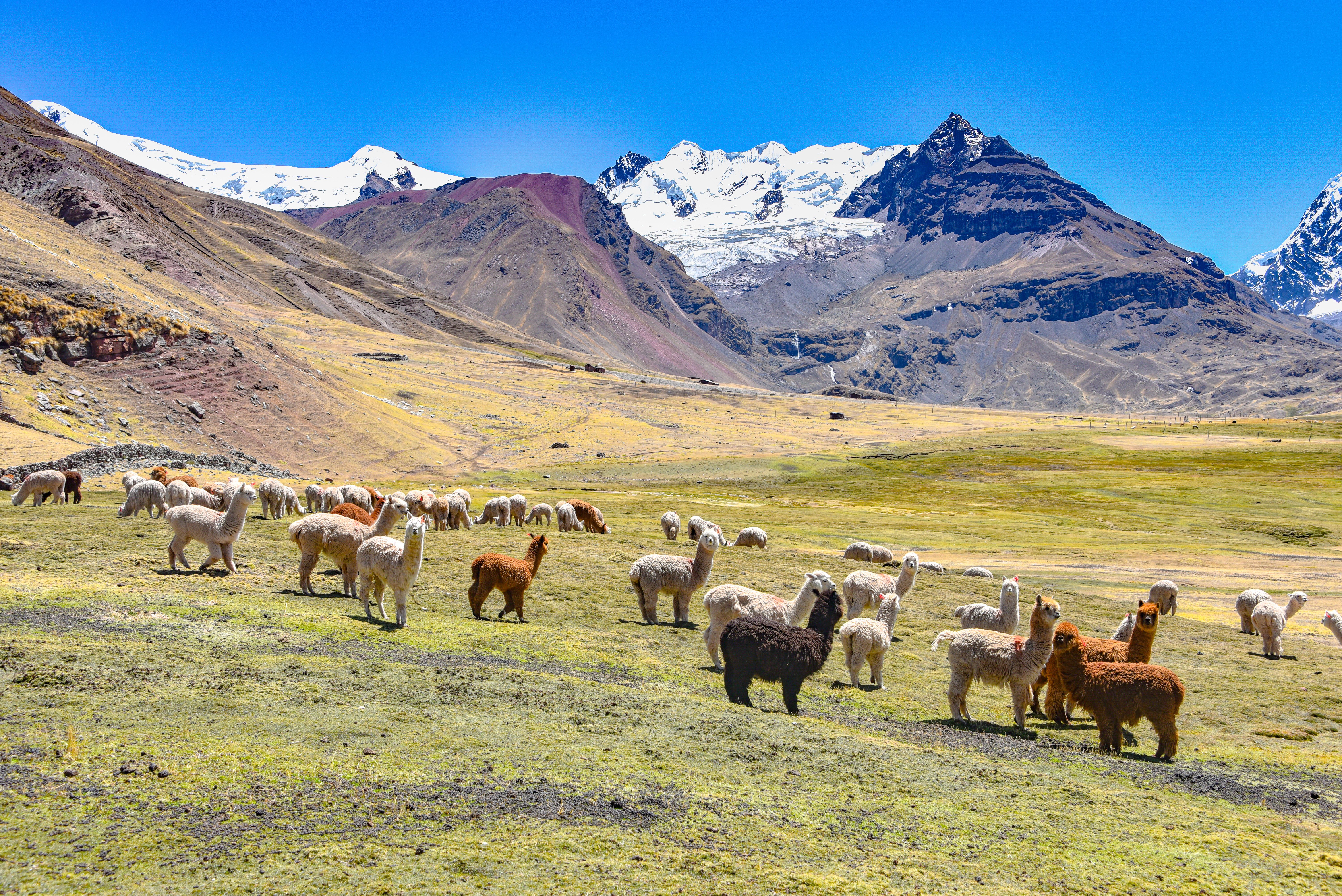
Agriculture.
Farming is extremely important to Peru’s economy. Many farm families own a small plot of land on which they produce barely enough to feed themselves. Most of Peru’s agricultural products come from the Andes Mountains and from along the coast. Peru’s leading crops include asparagus, coffee, cotton, grapes, onions, plantains, potatoes, rice, and sugar cane. Farmers also raise cattle for beef and milk and chickens for eggs and meat.
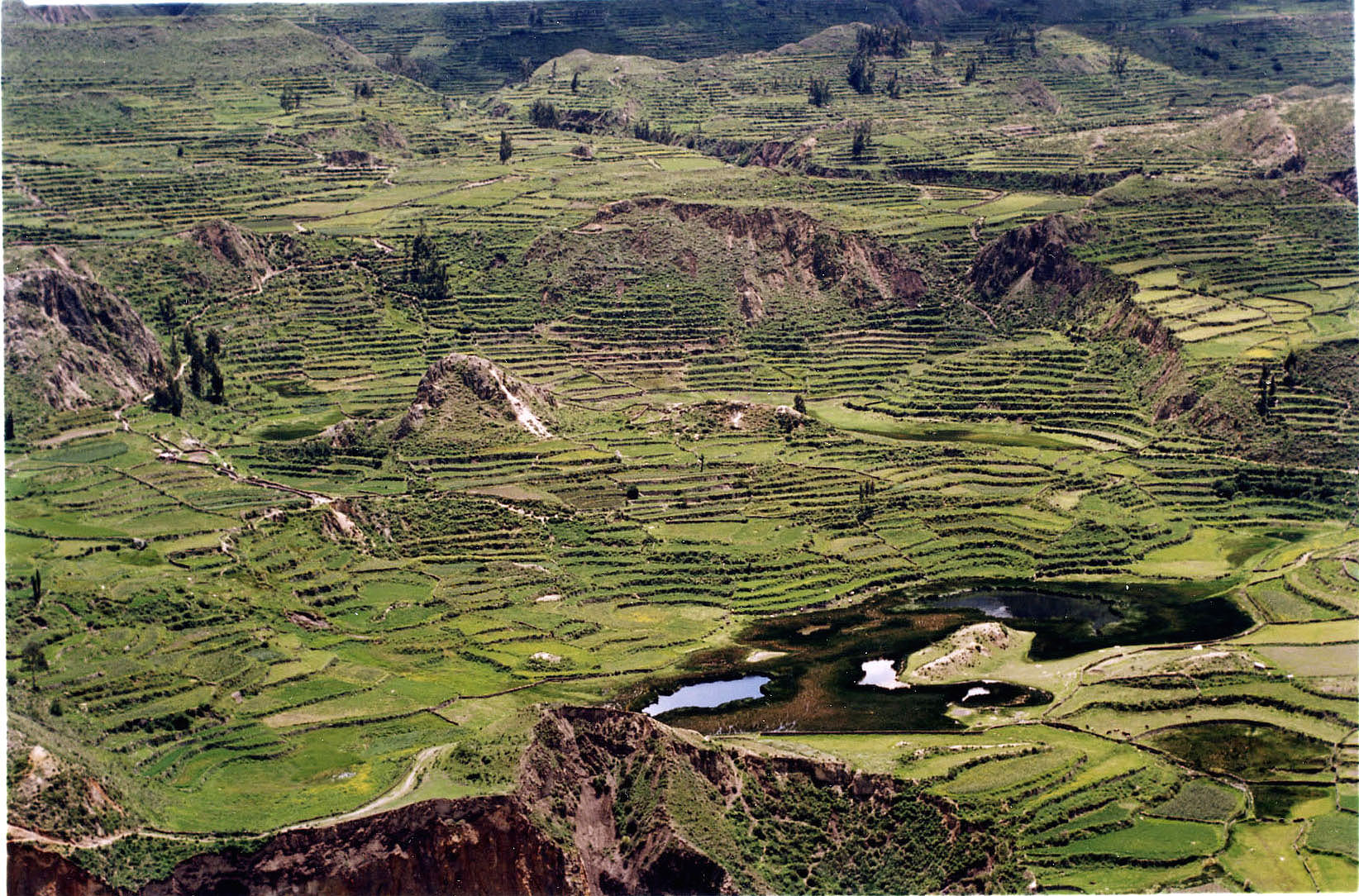
Mining.
Peru ranks among the world’s leading producers of copper, gold, lead, silver, and zinc. All these minerals are mined chiefly in the mountains of the Sierra. Rich iron ore mines lie on the far south coast. The north coast and the Selva have large petroleum deposits. Natural gas is mined at the southern end of the Selva. Peru also produces much clays, coal, molybdenum, and tin.
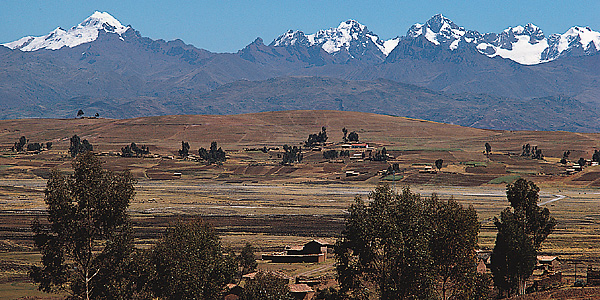
Many small islands off the Peruvian coast have large deposits of guano (bird droppings), which makes a good fertilizer. A government company mines the guano and sells it to mainland farmers.
Fishing.
Peru ranks among the leading fishing countries. Each year, the country’s fishing fleets take large quantities of anchovies (sometimes called anchovetas), mackerel, sardines, squids, and other fishing catches. Fish meal made from dried Peruvian sardines and anchovies is sold throughout the world for use in livestock feed. El Niño, a periodic change in the interaction between the atmosphere and the tropical Pacific waters that affects all areas of the Pacific, hurts the fishing industry. Aquaculture, the commercial raising of plants and animals that live in water, is a growing industry in Peru.
To avoid overfishing and to ensure a profitable catch by Peruvian vessels, Peru claims authority over waters up to 200 nautical miles (370 kilometers) off its coast. The government charges foreign vessels a high fee to fish in these waters and seizes vessels that refuse payment.
Manufacturing.
Much manufacturing in Peru is done on a small scale by individual craftworkers. But some manufacturing plants, chiefly along the coast, have numerous workers and use mass-production methods. Many of these plants process raw materials for export. The chief processed goods include cement, chemicals, clothing, fish meal, motor vehicles, paper products, petroleum products, processed foods, refined metals, steel, and textiles.
Trade.
Peru’s leading exports include clothing, coffee, copper, fish products, fruits, gold, petroleum products, and zinc. Imports include crude petroleum, food products, machinery, motor vehicles, and plastics.
China and the United States are Peru’s chief trading partners. Other important trading partners include Brazil, Canada, Chile, and Japan.
Transportation.
The rugged Andes hinder transportation across Peru. Most of the country’s roads are unpaved. Few Peruvians own a car. The Peruvian section of the Pan American Highway is the longest paved road. It runs along the coast. A branch of the highway extends southeast from the coast into Bolivia. A number of side roads run east from the highway into the highlands. Some of these roads continue into the Selva. However, most travel in the Selva is by river. Llamas often serve as pack animals in the highlands. The Interoceanic Highway links Peru’s Pacific coast with Brazil’s Atlantic coast.
Arequipa, Cusco, and Lima have international airports. Peru has few good natural harbors, but some harbors have developed into important seaports. Callao ranks as the chief international port.
The Central Railway extends from the Greater Lima area to mines and ore refineries that are high in the Andes. The railway climbs to 15,844 feet (4,829 meters) above sea level, and is one of the highest railways in the world. The Southern Railway connects the Peruvian port of Mollendo with Arequipa and other cities and towns in the southern highlands. For additional information about transportation in Peru, see Andes Mountains.
Communication.
Lima has several daily newspapers, and most other cities have at least one. Most Peruvian newspapers are privately owned, and they represent a variety of political viewpoints.
Radio is an important means of mass communication in Peru. Most Peruvian families own a transistor radio. Programs are broadcast in both Spanish and Quechua. The government operates some radio and television stations. Others are privately owned. Cellular telephone and internet services are growing rapidly. Most Peruvians who connect to the internet do so by phone.
History
Early inhabitants.
Scholars believe that the first people to live in Peru were Indigenous people who came from North America about 12,000 years ago. Gradually, the Indigenous people learned to farm. They tamed the llama and began to cultivate the potato, which grew wild in the highlands. Potatoes became an important food in Peru long before they were known anywhere else in the world. The Indigenous population also domesticated corn.
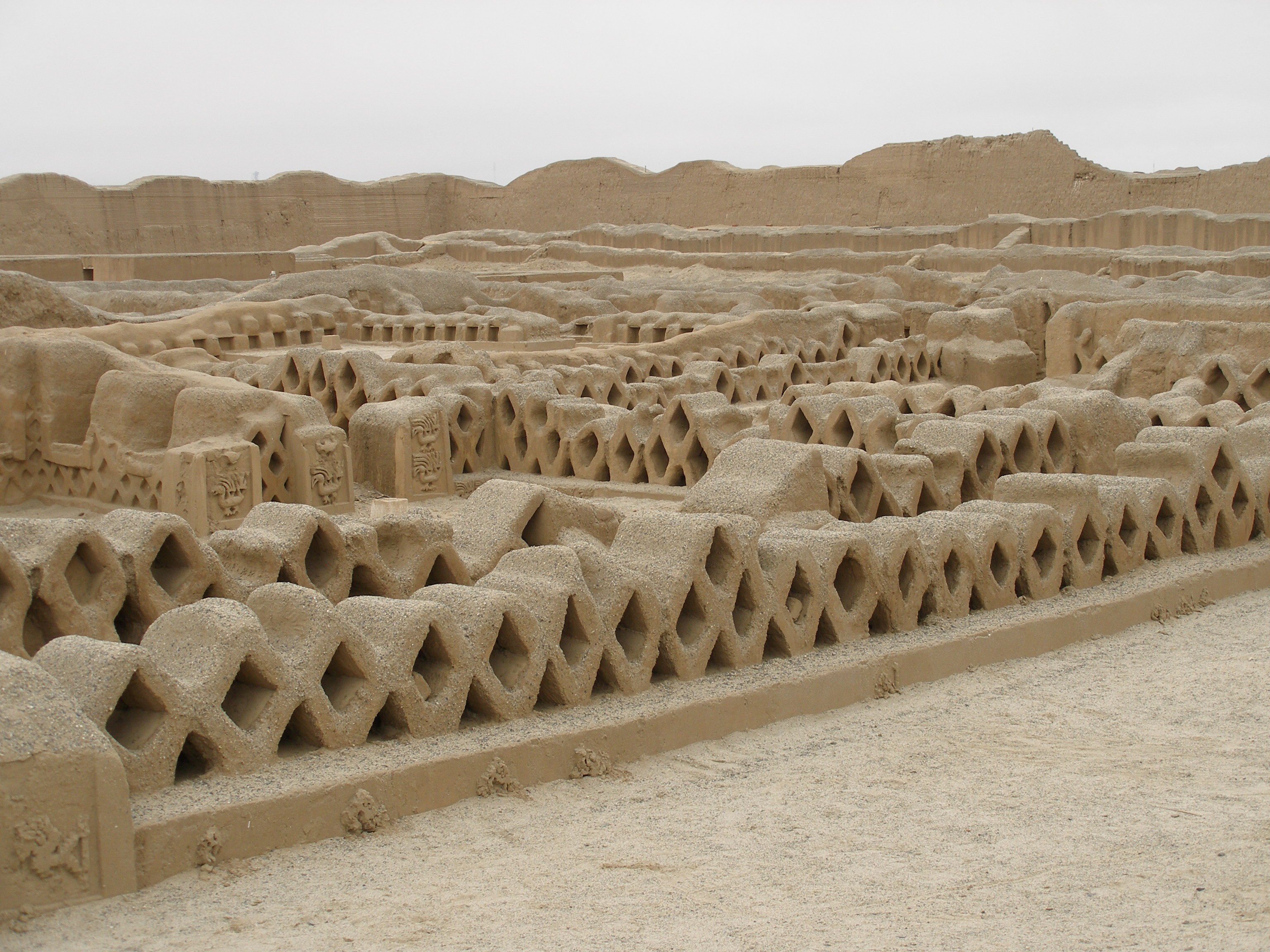
Peru was home to some of the earliest sedentary (non-nomadic) civilizations in the world. By 2800 B.C., the first large cities and ceremonial centers in Peru had been built along the coast in a region called Norte Chico. Since that time, a number of complex civilizations have risen and then declined. The Indigenous Chavin people developed a complex civilization that reached its peak from about 800 to 400 B.C. Other groups, such as the Moche (also called Mochica), Tiwanaku (also spelled Tiahuanaco), Chimu, and Nazca developed civilizations in Peru from 200 B.C. to A.D. 600. Beginning about A.D. 1000, the Chimu built a large capital city called Chan Chan on Peru’s northern coast. Chan Chan’s ruins cover about 8 square miles (20 square kilometers) near Trujillo.
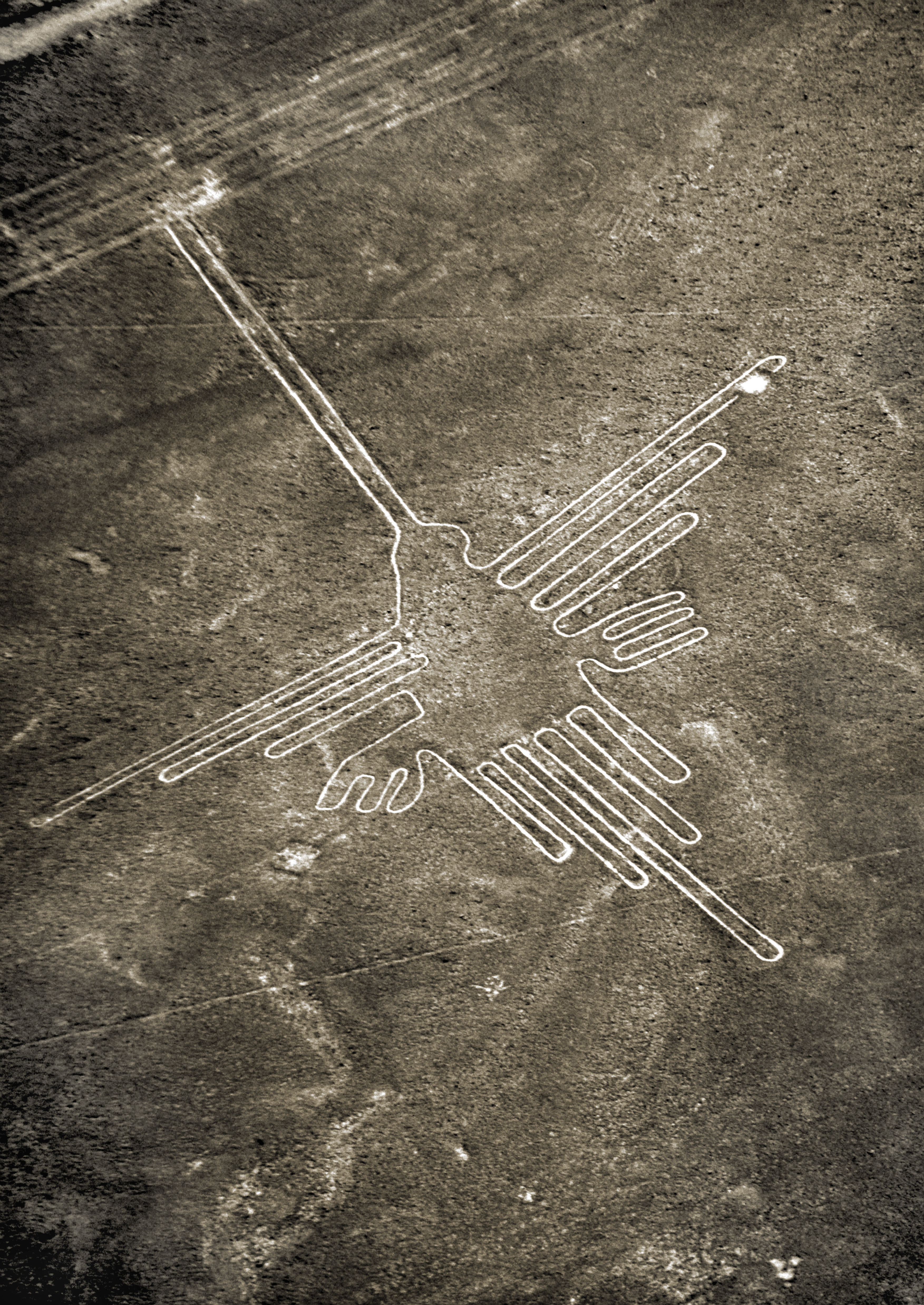
About 1200, a people called the Inca founded a kingdom in southern Peru. Based in their capital of Cusco high in the Andes, the Inca were master architects and roadbuilders, accurate astronomers, and dedicated lawmakers and warriors. In the mid-1400’s, the Inca began to expand rapidly and conquer neighboring groups. By the early 1500’s, they had built a great empire, and their civilization had reached its peak. Inca rule extended north into parts of present-day Colombia and Ecuador and south as far as present-day Chile and Argentina. See Inca.
Spanish conquest and rule.
In the mid-1520’s, the Spanish conquistador Francisco Pizarro began to explore the west coast of South America. He had heard tales of the Inca empire and of its treasures of silver and gold. About 1527, Pizarro and a few followers landed near the Inca city of Tumbes on Peru’s north coast. They became the first Europeans to set foot in Peru.
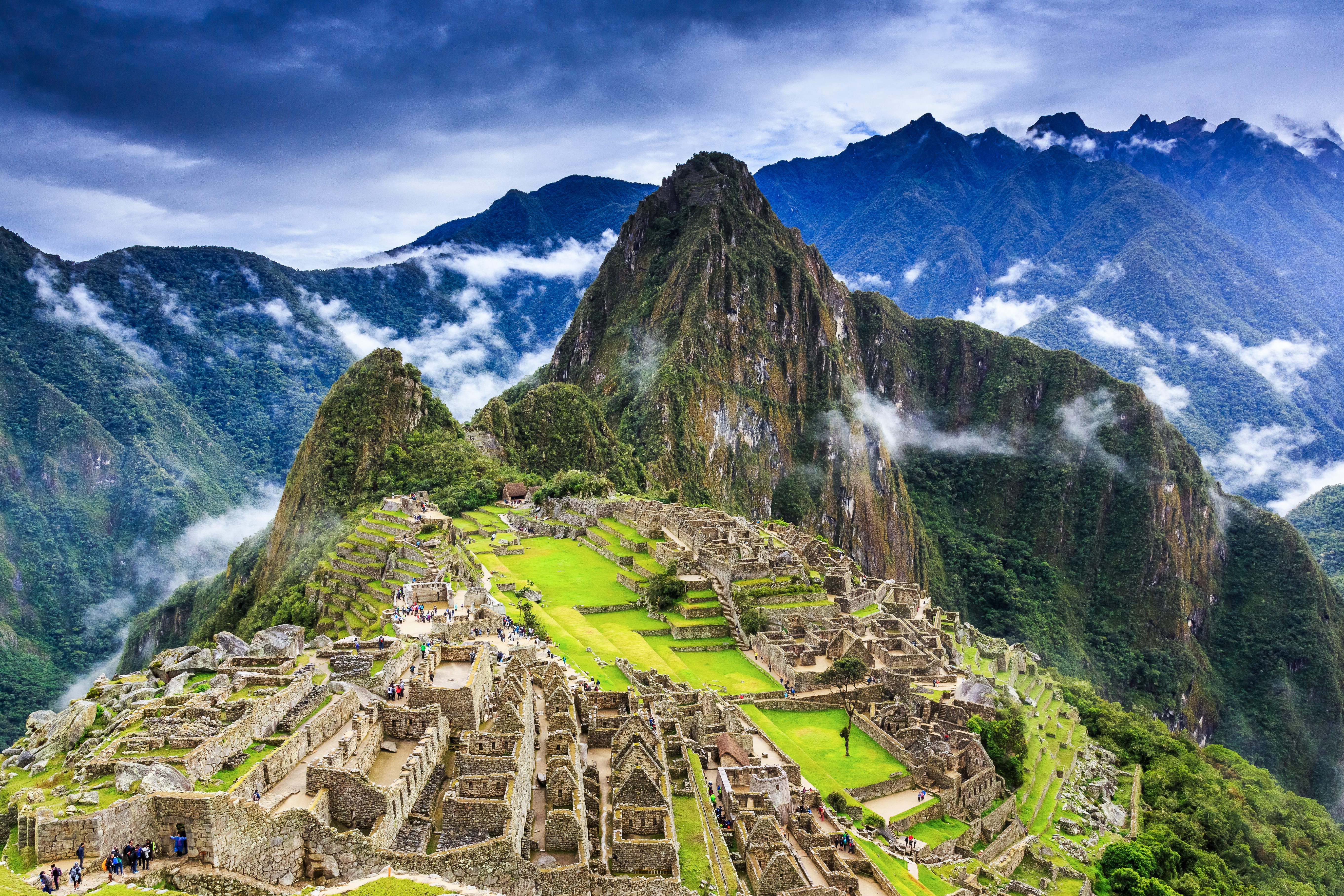
Pizarro saw enough riches at Tumbes to convince him that the legends about the Inca were true. He returned in 1532 with about 180 men, who were later joined by other Spanish troops. European diseases introduced by the Spaniards killed many Indigenous Peruvians. A civil war that occurred after the Inca emperor Huayna Capac died from disease divided the empire, further aiding Pizarro’s conquest. In 1532, Pizarro captured the new Inca ruler, Atahualpa. While holding him hostage, Pizarro captured most of the Inca territory. In 1533, Pizarro had Atahualpa killed and took control of Cusco. In 1535, Pizarro founded the city of Lima.
The Inca resisted Spanish rule. In 1536, Inca leaders revolted and founded a new capital named Vilcabamba, from which they ruled until 1572. That year, the Spaniards subdued the last Inca stronghold and executed Tupac Amaru I, the last Inca emperor.
Following the conquest, Spain implemented the encomienda system. This system rewarded conquistadors for their service to Spain by granting them rights to the products and labor of Indigenous communities. In return, the conquistadors, who became known as encomenderos, were expected to protect the laborers and to teach them the Christian faith. The encomenderos abused and took advantage of the Indigenous laborers. Competing for wealth and power, they fought with one another and against the colonial government. As a result, Spain replaced the encomienda system with the mita. Each Indigenous town was required to supply a set amount of free labor to work in mines and textile workshops and on large estates called haciendas. In return, Indigenous towns were given land and promised protections from competing haciendas and white settlers. 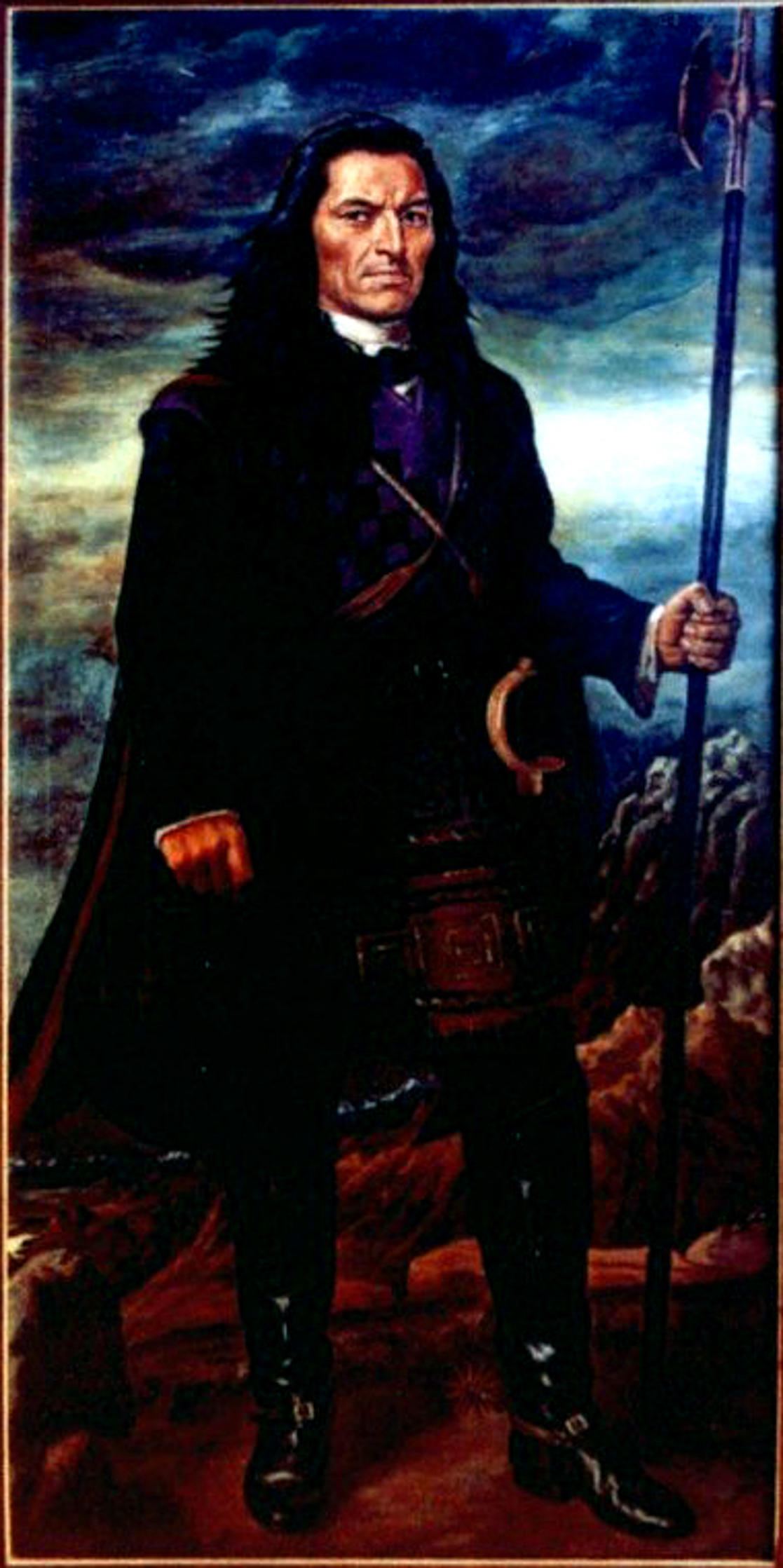
Despite such protections, life remained difficult for many Indigenous people. European diseases continued to reduce their numbers, and corrupt officials and abusive haciendas took advantage of them. The Indigenous people also had to make payments called tribute to the colonial government. Many refused to pay tribute or staged violent uprisings. Some also used the Spanish legal system to try to end abuses against the Indigenous population. In addition to using Indigenous labor, the Spaniards enslaved Africans and made them work on coastal plantations and as domestic help in cities.
In 1780, José Gabriel Condorcanqui, a leader in the Indigenous community, led an unsuccessful rebellion against the abuses of Spanish rule. He called himself Tupac Amaru II in honor of the last Inca emperor. Peru’s Spanish rulers captured Tupac Amaru II and executed him in 1781, but the revolt lasted several more years.
The war of independence.
Reliant upon the economic influence of the colonial government, and mindful of the violence of the Tupac Amaru II rebellion, Lima’s upper class was wary of declaring Peru’s independence from Spain. The chief heroes of Peru’s independence were José de San Martín of Argentina and Simón Bolívar of Venezuela. San Martín and Bolívar wanted to end European rule throughout South America, and Peru was the center of Spanish power on the continent.
San Martín’s army invaded Peru in 1820. He declared the country independent in 1821, though much of it remained under Spanish control. Bolívar led an army into Peru in 1823. The next year, Antonio José de Sucre, one of Bolívar’s generals, defeated a large Spanish force at Ayacucho in south-central Peru. The remaining Spanish troops held only the city of Callao. They finally surrendered in 1826. Although Peru had become free, Spain did not formally recognize its independence until 1879.
Some Indigenous people opposed independence, believing it threatened their rights under Spanish rule, such as the right to own land. After Peru became free from Spain, Indigenous people still paid tribute to the new government in exchange for the protection of their land.
The early republic.
Peruvians were divided over what type of country and government should be created. Many supported the continuation of colonial economic policies and laws that protected the Roman Catholic Church. The war of independence had destroyed much of Peru’s economy and its political institutions. As a result, military officers called caudillos came to hold power in the young nation. The caudillos often represented specific regional or political groups and fought with one another over control of the country.
One caudillo, Ramón Castilla, emerged as an important leader who would construct the modern Peruvian state. Castilla served as president from 1845 to 1851, and from 1855 to 1862. He developed Peru’s guano industry and opened trade with Europe and the United States. The resulting economic growth allowed Peru to expand its bureaucracy and build infrastructure. Castillo also ended Indigenous tribute payments and the institution of slavery in Peru.
The War of the Pacific
(1879-1883) began as a dispute between Bolivia and Chile over control of Bolivian nitrate deposits. Nitrates are minerals used to make fertilizer and explosives. Chile invaded Bolivia in 1879. Peru entered the conflict because it had secretly agreed to aid Bolivia in the event of war with Chile. Chilean troops occupied Lima in 1881 and seized Peru’s nitrate-rich southern provinces of Tacna, Arica, and Tarapacá. Chile also took nitrate-rich land along the Pacific Ocean from southwestern Bolivia, leaving Bolivia landlocked. The Treaty of Ancón ended the war in 1883. It allowed Chile to keep the captured Peruvian provinces, but Chile returned Tacna to Peru in 1929.
In the early 1900’s,
a small upper class of wealthy landowners exercised strong political and economic influence in Peru. During this period, called the Aristocratic Republic, many of Peru’s presidents also belonged to this elite class. The War of the Pacific had left Peru economically devastated. After the war, influential upper-class Peruvians encouraged foreign investment in Peru to help develop the country’s resources and reduce its debt. A number of U.S. companies invested in such industries as copper and oil production. The economy improved for a time. However, many Peruvians disliked the political control enjoyed by the elite class and by foreign companies.
In 1919, Augusto B. Leguía took control of Peru and established himself as a dictator. He claimed to represent the interests of working-class Peruvians. President Leguía borrowed large sums of money from U.S. banks to finance economic growth and infrastructure projects. In 1930, Peru felt the effects of the Great Depression, a major worldwide economic slump. The armed forces, alarmed by Peru’s economic and political instability, overthrew Leguía and made Colonel Luis Sánchez Cerro president.
Unlike Peru’s wealthy upper class, the peasant class lacked political influence during the early 1900’s. While in office, President Leguía issued laws to protect Indigenous lands, but his measures proved unsuccessful. A wave of Indigenous uprisings soon occurred. A movement known as Indigenismo brought attention to the poor living conditions of the Indigenous population.
The rise of APRA.
In 1924, Víctor Raúl Haya de la Torre founded the American Popular Revolutionary Alliance (APRA). This new political party called for state ownership of Peru’s basic industries and demanded equal rights for all citizens, including Indigenous people.
Haya de la Torre ran for president against Sánchez Cerro in 1931 and lost. APRA charged dishonesty in vote counting and staged violent antigovernment protests. The government then jailed or killed thousands of APRA supporters and banned the party from running political candidates. However, APRA continued to operate secretly and gained followers. In 1933, a member of APRA assassinated Sánchez Cerro as revenge for his persecution of the party.
Another military leader, Óscar R. Benavides, became president in 1933. Benavides continued the ban against APRA. But he enacted populist reforms (reforms to help the common people) to gain the support of workers. Manuel Prado, who succeeded Benavides in 1939, continued these reforms.
In 1945, President Prado ordered the first election since 1931 in which APRA candidates could take part. Rather than run its own candidate, APRA supported José Luis Bustamante, a respected lawyer and diplomat. Bustamante won the election by promising a series of populist reforms. Quarrels with political groups led APRA to acts of violence after the election, and President Bustamante outlawed the party in 1948.
Later in 1948, military leaders overthrew Bustamante’s government and named General Manuel Odría president. Odría worked to reduce APRA’s influence and restore the political influence of Peru’s wealthy upper class. However, he legalized APRA before the 1956 election, the first in which Peruvian women voted. Former president Manuel Prado gained APRA’s support and won the election.
In the 1950’s and early 1960’s, APRA began losing popularity because of Haya de la Torre’s increasing cooperation with former conservative rivals. Fernando Belaúnde Terry of the Popular Action Party was elected president in 1963.
Revolt and military rule.
From the 1920’s to the 1960’s, Peru’s government enacted some social and political reforms. However, real power remained with wealthy landowners and powerful agricultural export businesses that helped maintain Peru’s unequal social structure. During the 1950’s and 1960’s, the unequal distribution of land led to peasant revolts in various parts of Peru. Members of leftist political parties engaged in guerrilla warfare in an unsuccessful effort to achieve land reform. Many people acknowledged the need for change, but no social group had the will or the support to make reforms. President Belaúnde proposed reforms to address Peru’s inequalities, but his opponents in Congress blocked them.
In the mid-1960’s, Peru’s economy worsened and political and social instability increased. Many Peruvians blamed wealthy conservatives, as well as the United States, which had growing political and business interests in Peru. In 1968, Belaúnde reached a financial agreement with the U.S.-owned International Petroleum Company involving the use of Peruvian oil fields. His opponents charged that the agreement favored the company. A group of military leaders then staged a coup (sudden government take-over) and named General Juan Velasco Alvarado president.
The new government, which called itself the “Revolutionary Government of the Armed Forces,” enacted major economic reforms to benefit lower-class and Indigenous Peruvians. One of its most important reforms was the 1969 agrarian (agricultural) reform. Many of Peru’s large farms became cooperatives. The government also took control of U.S. companies in Peru. In the early 1970’s, it began a reform program that gave workers partial control over various industries.
By the mid-1970’s, the military government faced growing criticism. Civilians demanded a greater political voice. The government’s reforms increased the national debt and failed to deliver the desired economic growth. Inflation and unemployment added to public discontent. In 1975, military leaders named General Francisco Morales Bermúdez president. Morales Bermúdez modified many of the previous government’s reforms and announced a return to democracy.
Return to civilian government.
In 1980, the people elected a civilian government. Belaúnde was reelected president. He took steps to cut government spending and increase private enterprise in the hope of relieving some of Peru’s economic problems. Several leftist groups used the economic crisis to gain support against the government. The Shining Path, which became the largest and most violent of these groups, began an armed revolt in 1980. Belaúnde mobilized the armed forces to stop the revolt. As many as 70,000 people—mostly innocent Indigenous people—died in the conflict in the 1980’s and 1990’s. In 1985, Alan García Pérez of APRA was elected president. García introduced economic reforms, but they failed and caused further economic problems.
Peru under Fujimori.
In 1990, Alberto Fujimori, founder of the Change 90 political party, was elected president. Fujimori privatized most of Peru’s economic resources and welcomed foreign investment into Peru. He received credit for restoring economic growth to Peru. However, he drew criticism for violating human rights and civil liberties. In April 1992, Fujimori suspended the Constitution and dissolved the legislature, thus giving himself the power of a dictator. He claimed there was corruption in the government and accused officials of failing to pass reforms to eliminate drug trading and terrorism. Many Peruvians backed Fujimori because of his economic reforms and their fear of the Shining Path. In September, Peru’s National Police captured Shining Path leader Abimael Guzmán Reynoso, thus weakening the group.
Fujimori oversaw the writing of a new constitution that took effect in 1993 and enabled him to run for reelection. He was reelected in 1995, and again in 2000, after his supporters in Congress passed legislation to allow him another term. By 2000, Fujimori faced mounting evidence of corruption and human rights violations. Months after the election, a government bribery scandal led Fujimori to resign as president while visiting Japan. The Congress rejected his resignation, declared him “morally unfit,” and removed him from office.
Fujimori remained in exile. He was arrested in Chile in 2005 and extradited (handed over) to Peru in 2007. Fujimori then was tried and convicted of abuse of power, corruption, and political murders and kidnapping. He was sentenced to 25 years in prison.
The early 2000’s.
Presidents who succeeded Fujimori continued his pro-business, free-market policies. The economy continued to grow, but it featured high levels of inequality and informal employment. Although the country enjoyed a historic period of democratic government, political parties proved institutionally weak and unpopular, and widespread corruption persisted. Political conflict between the office of president and the Congress also troubled the government.
From 2001 to 2020, Peru had a series of seven different presidents. Many of them were accused of corruption during or after their terms. Several faced criminal charges related to a far-reaching bribery scheme involving the Brazilian construction group Odebrecht. Many of the members of Congress, who enjoyed legal immunity during their terms, also faced various corruption accusations in the early decades of the 2000’s.
In 2017, President Pedro Pablo Kuczynski granted Fujimori a humanitarian pardon, apparently on medical grounds. The Supreme Court overturned the pardon in 2018, finding that it had been politically motivated, and Fujimori was sent back to prison. Peru’s Constitutional Tribunal reinstated Fujimori’s pardon in 2022, and he was freed in 2023.
The COVID-19 pandemic (global outbreak of disease) that began in 2020 greatly impacted Peru’s public health and strained its economy. COVID-19 is a respiratory disease caused by a coronavirus. Measures to curb the outbreak in Peru included restrictions on people’s movements and public activities, and the eventual vaccination of most of the population. As of early 2023, there had been about 4 1/2 million confirmed cases of the coronavirus in Peru, and about 220,000 confirmed deaths from COVID-19. Peru ranked among the nations with the most confirmed cumulative deaths from the disease.
Socialist candidate Pedro Castillo was elected president in 2021. A schoolteacher and union activist from a rural area, he pledged to address poverty and inequality. Allegations of corruption troubled Castillo’s presidency. In 2022, he tried to dissolve the Congress shortly before it was due to vote on impeaching him. The Congress then voted to remove Castillo from office, and he was arrested. Vice President Dina Boluarte was sworn in as Peru’s first woman president. These events led to violent public protests in which dozens of people died. Many of the protesters were poor, rural Peruvians who supported Castillo.
